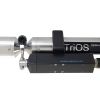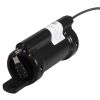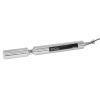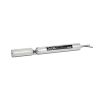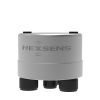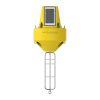TriOS NICO plus UV Nitrate Sensor
Features
- Internal compensation for temperature, turbidity, and organic substances
- RS-485 Modbus RTU output for integration with data collection platforms
- Optional W55 V2 wiper cleans optics & reduces maintenance intervals
- Expedited repair and warranty service
- Lifetime technical support
- More
The new TriOS NICO plus not only offers the parameters NO3-N, NO3, NOx-N and NOx previously known from NICO, but has now been expanded to include numerous additional parameters. These include UVT254, UVT254n, SAK254, CSBeq, BSBeq, TOCeq, DOCeq, turbidity and TSSeq.
An internal temperature correction additionally increases the stability of the measured values. Equipped with the innovative G2 interface with web browser configuration and internal data logger, NICO plus has features that are significantly above the currently available devices on the market, in combination with an attractive price.
The sensor can be easily integrated into existing process control systems and external data loggers using the native RS-485 Modbus RTU output, and the optional W55 V2 wiper reduces maintenance intervals by cleaning the optics before each measurement.
|
Light Source
|
Xenon flash lamp
|
|
|
Detector
|
4 photo diodes + filter
|
|
|
Measurement Principle
|
Attenuation
|
|
|
Optical Path
|
0,3 mm, 1 mm, 2 mm, 5 mm, 10 mm, 20 mm, 50 mm
|
|
|
|
||
|
Parameter
|
NO3-N, NO3, NOx-N, NOx, UVT254, UVT254n, SAC254, CODeq, BODeq, TOCeq, DOCeq, Turb, TSSeq
|
|
|
Measurement Range
|
See measurement ranges
|
|
|
Measurement Accuracy
|
± (5 % + 2-fold detection limit)
|
|
|
Turbidity Compensation
|
Yes
|
|
|
Data Logger
|
~ 2 GB
|
|
|
T100 Response Time
|
20 s
|
|
|
Measurement Interval
|
≥ 10 s
|
|
|
|
||
|
Housing Material
|
Stainless steel (1.4571/1.4404) or titanium (3.7035)
|
|
|
Dimensions (L x Ø)
|
~ 470 mm x 48 mm (10 mm path)
|
~ 18.5“ x 1.9“ (with10 mm path)
|
|
Weight (Stainless Steel)
|
~ 3 kg
|
~ 6.6 lbs
|
|
|
||
|
Digital Interface
|
Ethernet (TCP/IP), RS-485 (Modbus RTU)
|
|
|
Power Consumption
|
≤ 7 W
|
|
|
Power Supply
|
12...24 VDC (± 10 %)
|
|
|
|
||
|
Maintenance Effort
|
≤ 0.5 h/month (typical)
|
|
|
Calibration/Maintenance Interval
|
24 months
|
|
|
System Compatibility
|
Modbus RTU
|
|
|
Warranty
|
1 year (EU: 2 years)
|
USA: 2 years
|
|
|
||
|
Max. Pressure with SubConn
|
30 bar
|
~ 435 psig
|
|
Max. Pressure with Fixed Cable
|
3 bar
|
~ 43.5 psig
|
|
Max. Pressure in FlowCell
|
1 bar, 2...4 L/min
|
~ 14.5 psig at 0.5 to 1.0 gpm
|
|
Protection Type
|
IP68
|
NEMA 6P
|
|
|
||
|
Sample Temperature
|
+2...+40 °C
|
~ +36 °F to +104 °F
|
|
Ambient Temperature
|
+2...+40 °C
|
~ +36 °F to +104 °F
|
|
Storage Temperature
|
-20...+80 °C
|
~ -4 °F to +176 °F
|
|
Inflow Velocity
|
0,1...10 m/s
|
~ 0.33 to 33 fps
|
In The News
Great Lakes Research Center: Designing Targeted Monitoring Solutions
According to the National Oceanic and Atmospheric Administration ( NOAA ), the Great Lakes have more miles of coastline than the contiguous Atlantic and Pacific coasts combined and contain 20 percent of the world's freshwater, making it a critical region to protect and conserve. Continuous monitoring and data-informed resource management are key components of managing waters in the region. Hayden Henderson, a research engineer with the Great Lakes Research Center (GLRC), designs and deploys monitoring platforms throughout the Great Lakes. With a background in environmental engineering, Henderson enjoyed the challenge of creating systems and making them work to obtain difficult, remote measurements.
Read MoreWildfire Prevention in the Sierra Nevada Region with the Yuba Watershed Institute
Though recent wildfires have sparked new conversations about wildfire management and response, groups like the Yuba Watershed Institute have been monitoring the forests and water resources of the Sierra Nevada region for decades, managing approximately 5,000 acres of land with the Bureau of Land Management (BLM) and about 7,000 acres in private land partnerships. The goal of the Institute is to work with local communities and land agencies to improve watershed and forestry management through informed practices and public outreach. The goals of the Yuba Watershed Institute are three-fold: Improve the ability of fire suppression agencies like the California Department of Forestry and Fire Protection ( CAL FIRE ) and the US Forest Service.
Read MoreWave Sensors Integration with NexSens Buoys: A Cutting-Edge Solution for Wave Measurment
Real-time wave data supports accurate weather prediction, safe and efficient maritime operations, and provides valuable safety and operating condition information for recreation and commercial fishing. Understanding wave dynamics also helps with the design of protective coastal structures like seawalls, breakwaters, and jetties. It also supports better prediction of their impact on sediment transport and coastal geomorphology. Wave data is a key factor in qualifying and designing offshore wind farms and harnessing kinetic energy for electrical generation. It helps with the understanding of ocean-atmosphere interactions and contributes to studies of sea-level rise and climate change impacts.
Read More




























